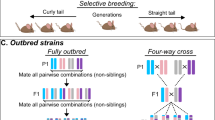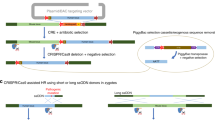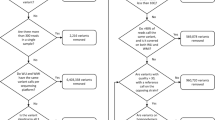Key Points
-
The rat is an important model organism for systems biology research, as it has a wealth of physiological and pharmacological data to offer, and more than 200 inbred models of human complex disease.
-
The Rat Genome Project is providing biologists with a powerful set of tools with which to develop better models of human disease at the phenotypic and genomic level.
-
The rat genome can be annotated with biological functions that can relate to complex disease. Methods for doing this range from quantitative trait loci mapping in inbred rat strains to developing and studying congenic, consomic and transgenic rat strains to facilitate gene discovery and a better understanding of the genes that underlie complex disease.
-
Comparative genomics allows different types of information that have been derived from various model organisms to be integrated to generate a synergistic platform for understanding complex disease mechanisms.
Abstract
During the past five years, the Rat Genome Project has been rapidly gaining momentum, especially since the announcement in August 2000 of plans to sequence the rat genome. Combined with the wealth of physiological and pharmacological data for the rat, the genome sequence should facilitate the discovery of mammalian genes that underlie the physiological pathways that are involved in disease. Most importantly, this combined physiological and genomic information should also lead to the development of better pre-clinical models of human disease, which will aid in the development of new therapeutics.
This is a preview of subscription content, access via your institution
Access options
Subscribe to this journal
Receive 12 print issues and online access
$189.00 per year
only $15.75 per issue
Buy this article
- Purchase on Springer Link
- Instant access to full article PDF
Prices may be subject to local taxes which are calculated during checkout



Similar content being viewed by others
References
Lindsey, J. R. in The Laboratory Rat (eds Baker, H. J., Lindsey, J. R. & Weisbroth, S. H.) 1–36 (Academic, New York, 1979).
Nishioka, Y. The origin of common laboratory mice. Genome 38, 1–7 (1995).
Gill, T. J. D., Smith, G. J., Wissler, R. W. & Kunz, H. W. The rat as an experimental animal. Science 245, 269–276 (1989).
Greenhouse, D. D., Festing, M. F. W., Hasan, S. & Cohen, A. L. in Genetic Monitoring of Inbred Strains of Rats (ed. Hedrich, H. J.) (Gustav Fischer, Stuttgart, 1990).
Jacob, H. J. et al. Genetic mapping of a gene causing hypertension in the stroke-prone spontaneously hypertensive rat. Cell 67, 213–224 (1991).
Paterson, A. H. et al. Resolution of quantitative traits into Mendelian factors by using a complete linkage map of restriction fragment length polymorphisms. Nature 335, 721–726 (1988). This is the first paper that used a whole-genome scan to map QTL.
Todd, J. A. et al. Identification of susceptibility loci for insulin-dependent diabetes mellitus by trans-racial gene mapping. Nature 338, 587–589 (1989).
Hilbert, P. et al. Chromosomal mapping of two genetic loci associated with blood pressure regulations in hereditary hypertensive rats. Nature 353, 521–529 (1991).
Rapp, J. P. in Hypertension, 2nd edn (eds Genest, J., Kuchel, O., Hamet, P. & Cantin, M.) 534–555 (McGraw–Hill, New York, 1983).
Rapp, J. Genetic analysis of inherited hypertension in the rat. Physiol. Rev. 80, 135–172 (2000). An excellent review for investigators who are interested in the genetic basis of hypertension in rats.
Yamori, Y. in Hypertension 2nd edn (eds Genest, J., Kuchel, O., Hamet, P. & Cantin, M.) (McGraw–Hill, New York, 1983).
Colle, E., Guttmann, R. D., Seemayer, T. A. & Michel, F. Spontaneous diabetes mellitus syndrome in the rat. IV. Immunogenetic interactions of MHC and non-MHC components of the syndrome. Metab. Clin. Exp. 32, 54–61 (1983).
Mordes, J. P., Desemone, J. & Rossini, A. A. The BB rat. Diabetes Metab. Rev. 3, 725–750 (1987).
Mullins, J. J., Peters, J. & Ganten, D. Fulminant hypertension in transgenic rats harbouring the mouse Ren-2 gene. Nature 344, 541–544 (1990).
Zhang, Y. et al. Positonal cloning of the mouse obese gene and its human homologue. Nature 372, 425–432 (1994).
Huang, L., Wang, Z. & Li, C. Modulation of circulating leptin levels by its soluble receptor. J. Biol. Chem. 276, 6343–6349 (2001).
Capecchi, M. Altering the genome by homologous recombination. Science 244, 1288–1292 (1989).
Todd, J. From genome to aetiology in a multifactorial disease, type 1 diabetes. Bioessays 21, 164–174 (1999).
Merriman, T. et al. Suggestive evidence for association of human chromosome 18q12–q21 and its orthologue on rat and mouse chromosome 18 with several autoimmune diseases. Diabetes 50, 184–194 (2001).
Hamet, P., Pausova, Z., Adarichev, V., Adaricheva, K. & Tremblay, J. Hypertension: genes and environment. J. Hypertens. 16, 397–418 (1998).
Fijneman, F., De Vries, S., Jansen, R. & Demant, P. Complex interactions of new quantitative trait loci, Sluc1, Sluc2, Sluc3, and Sluc4, that influence the susceptibility to lung cancer in the mouse. Nature Genet. 14, 465–467 (1996).
Nagase, H., Bryson, S., Fee, F. & Balmain, A. Multigenic control of skin tumour development in mice. Ciba Found. Symp. 197, 156–168 (1996).
Lengeling, A., Pfeffer, K. & Balling, R. The battle of two genomes: genetics of bacterial host/pathogen interactions in mice. Mamm. Genome 12, 261–271 (2001).
Bice, P. et al. Genomic screen for QTLs underlying alcohol consumption in the P and NP rat lines. Mamm. Genome 9, 949–955 (1998).
Grisel, J. Quantitative trait locus analysis. Alcohol Res. Health 24, 169–174 (2000).
Nadeau, J. & Frankel, W. The roads from phenotypic variation to gene discovery: mutagenesis versus QTLs. Nature Genet. 25, 381–384 (2000).
Frary, A. et al. fw2.2: a quantitative trait locus key to the evolution of tomato fruit size. Science 289, 85–88 (2000). This paper reports the first gene to be cloned by using only positional information, and came out of the first whole-genome scan for QTL.
Horikawa, Y. et al. Genetic variation in the gene encoding calpain-10 is associated with type 2 diabetes mellitus. Nature Genet. 26, 163–175 (2000).
Hugot, J. et al. Association of NOD2 leucine-rich repeat variants with susceptibility to Crohn's disease. Nature 411, 599–603 (2001).
Ogura, Y. et al. A frameshift mutation in NOD2 associated with susceptibility to Crohn's disease. Nature 411, 603–606 (2001).
Flint, J. & Mott, R. Finding the molecular basis of quantitative traits: successes and pitfalls. Nature Rev. Genet. 2, 437–445 (2001). An excellent review on finding the genes that underlie QTL.
Podolin, P. et al. Localization of two insulin-dependent diabetes (Idd) genes to the Idd10 region on mouse chromosome 3. Mamm. Genome 9, 283–286 (1998).
Legare, M., Bartlett, F. N. & Frankel, W. A major QTL determined by multiple genes in epileptic EL mice. Genome Res. 10, 42–48 (2000).
Morel, L., Blenman, K., Croker, B. & Wakeland, E. The major murine systemic lupus erythematosus susceptibility locus, Sle1, is a cluster of functionally related genes. Proc. Natl Acad. Sci. USA 98, 1787–1792 (2001).
Pravenec, M. et al. Transgenic rescue of defective Cd36 ameliorates insulin resistance in spontaneously hypertensive rats. Nature Genet. 27, 156–158 (2001).
Aitman, T. et al. Quantitative trait loci for cellular defects in glucose and fatty acid metabolism in hypertensive rats. Nature Genet. 16, 197–201 (1997).
Aitman, T. J. et al. Identification of Cd36 (Fat) as an insulin-resistance gene causing defective fatty acid and glucose metabolism in hypertensive rats. Nature Genet. 21, 76–83 (1999).
Smith, D. et al. Functional screening of 2 Mb of human chromosome 21q22.2 in transgenic mice implicates minibrain in learning defects associated with Down syndrome. Nature Genet. 16, 28–36 (1997).
Symula, D. J. et al. Functional screening of an asthma QTL in YAC transgenic mice. Nature Genet. 23, 241–244 (1999). This paper set the stage for a series of papers based on the functional analysis of genes that are contained in YACs. This is a potential model for investigators looking to positionally clone genes in rats.
Zhang, Y., Buchholz, F., Muyrers, J. P. & Stewart, A. F. A new logic for DNA engineering using recombination in Escherichia coli. Nature Genet. 20, 123–128 (1998).
Muyrers, J., Zhang, Y., Testa, G. & Stewart, F. Rapid modification of bacterial artificial chromosomes by ET-recombination. Nucleic Acids Res. 27, 1555–1557 (1999).
Mackay, T. F. Quantitative trait loci in Drosophilia. Nature Rev. Genet. 2, 11–20 (2001).
Iannaccone, P., Taborn, G. & Garton, R. Preimplantation and postimplantation development of rat embryos cloned with cumulus cells and fibroblasts. Zygote 9, 135–143 (2001).
Hayes, E. et al. Nuclear transfer of adult and genetically modified fetal cells of the rat. Physiol. Genomics 5, 193–204 (2001).
Legare, M. E., Bartlett, F. S. & Frankel, W. N. A major effect QTL determined by multiple genes in epileptic EL mice. Genome Res. 10, 42–48 (2000).
Justice, M. Capitalizing on large-scale mouse mutagenesis screens. Nature Rev. Genet. 1, 109–115 (2000).
Previtali, S. et al. Laminin receptor α6β4 integrin is highly expressed in ENU-induced glioma in rat. Glia 26, 55–63 (1999).
Vincent, M. et al. A pharmacogenetic approach to blood pressure in Lyon hypertensive rats. A chromosome 2 locus influences the response to a calcium antagonist. J. Clin. Invest. 100, 2000–2006 (1997).
Staessen, J. et al. The deletion/insertion polymorphism of the angiotensin converting enzyme gene and cardiovascular–renal risk. J. Hypertens. 15, 1579–1592 (1997).
Julier, C. et al. Genetic susceptibility for human familial essential hypertension in a region of homology with blood pressure linkage on rat chromosome 10. Hum. Mol. Genet. 6, 2077–2085 (1997).
Mansfield, T. A. et al. Multilocus linkage of familial hyperkalaemia and hypertension, pseudohypoaldosteronism type II, to chromosomes 1q31– 42 and 17p11–q21. Nature Genet. 16, 202–205 (1997).
Wilson, F. et al. Human hypertension caused by mutations in WNK kinases. Science 293, 1107–1112 (2001).
Stoll, M. et al. New target regions for human hypertension via comparative genomics. Genome Res. 10, 473–482 (2000). The first paper to transfer QTL data between several rat and human studies.
Tanase, H., Suzuki, Y., Ooshima, A., Yamori, Y. & Okamoto, K. Genetic analysis of blood pressure in spontaneously hypertensive rats. Jpn. Circ. J. 34, 1197–1212 (1970).
Sugiyama, F. et al. Concordance of murine quantitative trait loci for salt-induced hypertension with rat and human loci. Genomics 71, 70–77 (2001).
Perusse, L. et al. The human obesity gene map: the 2000 update. Obes. Res. 9, 135–169 (2001).
Becker, K. et al. Clustering of non-major histocompatibility complex susceptibility candidate loci in human autoimmune diseases. Proc. Natl Acad. Sci. USA 95, 9979–9984 (1998).
Griffiths, M., Encinas, J., Remmers, E., Kuchroo, V. & Wilder, R. Mapping autoimmunity genes. Curr. Opin. Immunol. 11, 689–700 (1999).
Kwitek-Black, A. E. et al. Automated construction of high-density comparative maps between rat, human, and mouse. Genome Res. 11, 1935–1943 (2001).
Talbot, C. et al. High-resolution mapping of quantitative trait loci in outbred mice. Nature Genet. 21, 305–308 (1999).
Kohn, M., Pelz, H.-J. & Wayne, R. Natural selection mapping of the warfarin-resistance gene. Proc. Natl Acad. Sci. USA 97, 7911–7915 (2000).
Peissel, B. et al. Linkage disequilibrium and haplotype mapping of a skin cancer susceptibility locus in outbred mice. Mamm. Genome 11, 979–981 (2000).
Grupe, A. et al. In silico mapping of complex disease-related traits in mice. Science 292, 1915–1918 (2001). An intriguing paper that uses linkage disequilibrium mapping to localize QTL. It remains to be validated by other groups.
Steen, R. G. et al. A high-density intergrated genetic linkage and radiation hybrid map of the laboratory rat. Genome Res. 9, AP1–AP8 (1999).
Reich, D. et al. Linkage disequilibrium in the human genome. Nature 411, 199–204 (2001).
Taylor, B. A. in Origins of Inbred Mice (ed. Morse, H. C.) 423–438 (Academic, New York, 1978).
Pravenec, M., Klir, P., Kren, V., Zicha, J. & Kunes, J. An analysis of spontaneous hypertension in spontaneously hypertensive rats by means of new recombinant inbred strains. J. Hypertens. 7, 217–221 (1989).
Groot, P. C. et al. The recombinant congenic strains for analysis of multigenic traits: genetic composition. FASEB J. 6, 2826–2835 (1992).
Stassen, A., Groot, P., Eppig, J. & Demant, P. Genetic composition of the recombinant congenic strains. Mamm. Genome 7, 55–58 (1996).
Nadeau, J., Singer, J., Matin, A. & Lander, E. Analysing complex genetic traits with chromosome substitution strains. Nature Genet. 24, 221–225 (2000).
O'Brien, S. et al. The promise of comparative genomics in mammals. Science 286, 458–462 (1999).
Stoll, M. et al. A genomic-systems biology map for cardiovascular function. Science 294, 1723–1726 (2001).
Acknowledgements
H.J.J. and A.E.K. are supported by grants from the National Institutes of Health.
Author information
Authors and Affiliations
Corresponding author
Related links
Related links
DATABASES
pseudohypoaldosteronism type II
type II (non-insulin-dependent) diabetes
FURTHER INFORMATION
Baylor College of Medicine ENU mutagenesis screen
GSF ENU Mouse Mutagenesis Project
Harwell ENU mutagenesis programme
McLaughlin Research Institute ENU mutagenesis screen
QTL maps and physiological profiles
Strain query form at Rat Genome Database
US National Heart, Lung, and Blood Institute — Programs for Genome Applications
Glossary
- INBRED STRAIN
-
A strain that is generated through systematic inbreeding, which fixes certain alleles in a strain so that they replace all other alleles that were present in an outbred population.
- QUANTITATIVE TRAIT LOCUS
-
(QTL). A genetic locus that is identified through the statistical analysis of complex traits (such as height or body weight). These traits are typically affected by more than one gene and also by the environment.
- CONGENIC
-
A strain that is produced by a breeding strategy in which recombinants between two inbred strains are backcrossed to produce a strain that carries a single segment from one strain on the genetic background of the other. The selected segment can contain a quantitative trait locus.
- CONSOMIC
-
A strain that is produced by a breeding strategy in which recombinants between two inbred strains are backcrossed to produce a strain that carries a single chromosome from one strain on the genetic background of the other.
- SYSTEMS BIOLOGY
-
The investigation of all of the elements of a particular biological system, rather than of individual genes or proteins. Systems biology aims to investigate the behaviour and relationships of all of the elements in a particular biological system.
- MARKER-ASSISTED SELECTION
-
The use of genetic markers to predict the inheritance of alleles at a closely linked trait locus.
- INTROGRESSION
-
Transfer of genetic material from one strain to another by repeated backcrosses.
- COMPLEMENTATION TEST
-
A breeding strategy to test whether two mutations are non-allelic when combined in an organism. If the resulting phenotype is wild type, the mutations are non-allelic and said to complement each other.
- QUANTITATIVE COMPLEMENTATION
-
A breeding strategy to identify genes that contribute to a quantitative trait locus (QTL). A QTL allele is crossed to animals that carry null mutations at each candidate gene in the QTL. If the phenotypic effect of the QTL allele on the progeny is not the same in mutant and wild-type backgrounds, allelism (quantitative non-complementation) between the mutant gene and the gene in the QTL is indicated.
- ORTHOLOGOUS GENE
-
Homologous gene in different species, the lineage of which derives from a common ancestral gene without gene duplication or horizontal transmission.
- BARORECEPTOR REFLEX
-
A reflex with a negative-feedback loop system; as blood pressure increases or decreases, the baroreceptor detects the event and initiates a cascade of physiological mechanisms that results in a return to baseline blood pressure.
- LINKAGE DISEQUILIBRIUM
-
The condition in which the frequency of a particular haplotype for two loci is significantly greater or less than that expected from the product of the observed allelic frequencies at each locus.
Rights and permissions
About this article
Cite this article
Jacob, H., Kwitek, A. Rat genetics: attachign physiology and pharmacology to the genome. Nat Rev Genet 3, 33–42 (2002). https://doi.org/10.1038/nrg702
Issue Date:
DOI: https://doi.org/10.1038/nrg702
This article is cited by
-
Development and Optimization of a Multilayer Rat Purkinje Neuron Culture
The Cerebellum (2023)
-
Perfect and imperfect views of ultraconserved sequences
Nature Reviews Genetics (2022)
-
The effect of laparoscopy on mast cell degranulation and mesothelium thickness in rats
BMC Surgery (2020)
-
Combinations of chromosome transfer and genome editing for the development of cell/animal models of human disease and humanized animal models
Journal of Human Genetics (2018)
-
Targeted expression of step-function opsins in transgenic rats for optogenetic studies
Scientific Reports (2018)



